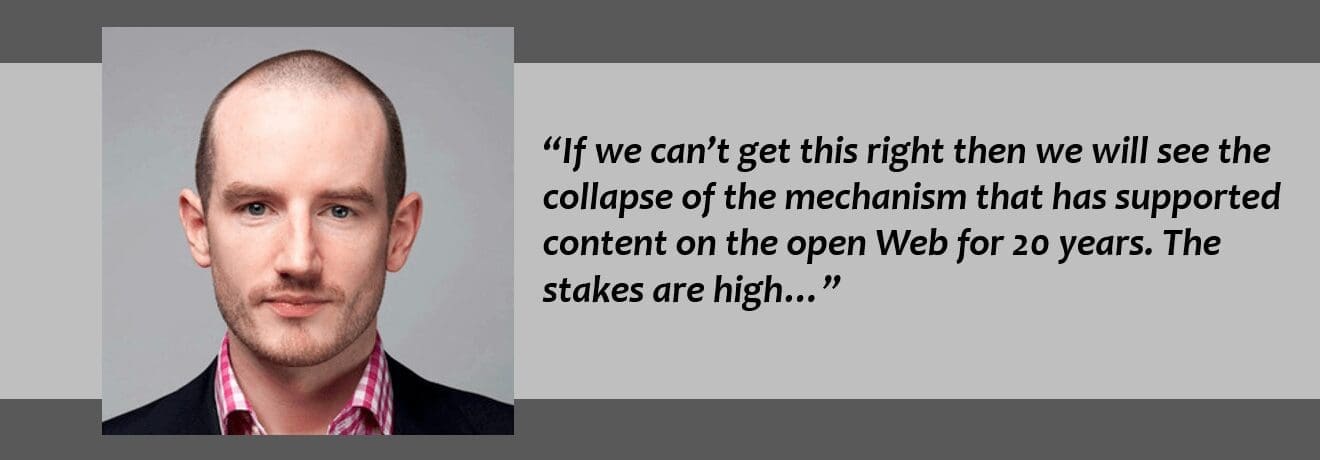
Unleash the true value of your data with our center of excellence, Proove Intelligence.

While attending Ad-Tech Canada 2016 in Toronto last month, I sat in on a panel discussing the pros and cons of ad blocking where I was introduced to the concept of ‘ad blocking blockers’. I was fortunate to connect with Dr. Johnny Ryan, Head of Ecosystems at PageFair, to recap the conference and dive deeper into this crucial debate.
What is the mission of PageFair and why do you feel this type of tool is important?
What we are working on is how to make the best for the medium. PageFair does two things – we have the technology to put ads back and we aide in figuring out what types of ads to put back. We believe we have a responsibility to figure out a legitimate, sustainable, long-term approach to advertising on the Web. If we can’t get this right then we will see the collapse of the mechanism that has supported content on the open web for 20 years. The stakes are high.
Who feels the effects of ad blocking the most? Is it the publishers, the advertisers, the brands?
The people that are feeling the real pain are the publishers. When an ad is blocked the publisher is not able to monetize that visitor to their website. The advertiser is not out of pocket because the ad is not even requested so there are no accounting issues. Depending on the publisher they might be feeling that pain acutely. In some niches this is life and death. For publishers of all sizes there is a very useful moment of reflection happening. Everyone now accepts that something has gone wrong with advertising on the Web.
The other stakeholders that are involved here are the advertisers and the agencies. There is also a dawning realization among those parties. The consumer action has definitely shone a light on an important fact: for 20 years no one has been particularly concerned about what the consumer thought. So now the consumer is having his/her day and everyone in the ecosystem is being forced to acknowledge that. This is definitely a good thing.
Even though it is causing a tremendous amount of pain today I do believe that a few years from now the industry as a whole will look back on this and regard the advent of ad blocking as being a useful reset. It has forced a rethink of what the practice ought to be and what the consumer should be exposed to.
What types of behaviours have you noticed with people using ad blockers? Are their variations between age, gender, geographic area etc?
Depending on the category of content you are looking at you see a widely different block rate. Websites that focus on government affairs are seeing invariably low ad-blocking. It scales up as you get into things like pornography or video game websites. You can see there is a demographic shift toward young, millennial males. The highest rates are for sites with video content. I can give you an example – the average for news or media sites is about 10% but that is based on the assumption that the content is mostly text. If it is mainly video those numbers can jump as high as 60%.
Can you speak more about your efforts to help define what is considered an acceptable and an unacceptable ad?
I believe that we are not the ones who should be defining what is and is not acceptable. I don’t think that should come from a vendor with an interest in the space necessarily. It certainly shouldn’t come from the ad blockers – that would be a bizarre situation.
So who does have the authority to draw a line in the sand?
I think there are a few legitimate parties here. First and foremost there are consumer groups, publishers, trustees of the web (certain browsers and people like the WC3) and it also includes advertisers. There are a lot of parties to bring together. One of the ways that PageFair fits in is getting all of these parties in the same room. I just coordinated a meeting between quite a few of these parties including the World Federation of Advertisers, Mozilla, and the World Association of News Publishers. What came out of that meeting is a basis for a tentative consensus on what types of ads should be restored.
And what were the takeaways?
The first question we asked ourselves was ‘is it a good idea to restore a vast quantity of ads on the web or should one take the opportunity to say you know what ads on the web can be a premium thing if we limit the number of spots that are available’? With this model the advertiser will be incentivized to invest in a higher quality ad. Right now we have all these ‘belly fat’ ads and it has become a shouting match between them. Imagine if instead of having ten or twenty ads on a page you had one ad every few pages or some significantly lesser number. This is a novel idea.
The second discussion point was around privacy and tracking. The Internet is often where one goes to do things that one would not do on a public street. Users can find it scary when they have a realization that there is an architecture that has some awareness of their behaviour across websites. This is often a motivator when deciding to use an ad blocker. When people are blocking ads they are simultaneously blocking most of the behavioural tracking as well.
Subscribe to our monthly newsletter.
When PageFair put ads in front of people on the blocked web we are not restoring that tracking. Under this proposed model we are talking about premium inventory that is being seen by essentially cookie-less users. But this raises an interesting question – if you can’t use all of the behavioural tracking, which most of the industry has sworn by, how do you make the ad relevant to them? The answer we came up with is that there is no particularly good reason not to use the context of the content of which the ad appears.
Let’s use a PGA tournament as an example. If I am on The Guardian or The New York Times reading about golf is that not the perfect space for Callaway to show me an ad for a new driver? This mirrors the system that you find in magazines, radio, print and every other medium over the last 100 years. And it works and has been effective at building brands.
That is a really interesting concept. I feel that we may overcomplicate things or force innovation even though a proven solution already exists. What will happen if the industry can’t figure this out or refuse to buy into this new philosophy?
Right now what is happening is that ad blocking is growing at a steady pace. I don’t want to suggest that the sky will fall tomorrow but it is believable that what we are seeing is synonymous with the first remote controls that were introduced in the 1950’s. Now that the genie is out of the bottle it is conceivable that we could see ad blocking as a standard thing. We will eventually get to a point where far more people than not are ad blocking.
What do you think the landscape will look like in the near future?
I think what we are going to be seeing in the not too distant future is that part of the “blocked web” will be where you see really premium, respectful ads that actually make you think of the magazine glossy ad. At the same time I do not suggest that the industry will stop investing in behavioural tracking and so on. I think we will start to see a kind of parallel situation where there is the normal web where the majority will continue not to block for quite some time. We are going to see sophisticated tracking and all of those technologies continue to evolve. But in parallel there is safe space on the blocked web where the agencies can experiment with the world beyond ad blocking (because I do think it will become inevitable that this will become the norm.) I think they will continue their ad activities and technologies but they will also be dipping in the blocked web and starting to investigate this idea of premium, more respectful advertising with almost no tracking.
About PageFair – Founded in 2012 PageFair is an international startup based in Dublin, Ireland. They aim to help create a more sustainable advertising ecosystem, one in which publishers can focus on loyalty and engagement instead of traffic and clicks, and make money without depleting their audiences goodwill.
Contact DAC today to find out more!
Unleash the true value of your data with our center of excellence, Proove Intelligence.
Unleash the true value of your data with our center of excellence, Proove Intelligence.
Unleash the true value of your data with our center of excellence, Proove Intelligence.
Subscribe to our monthly newsletter.